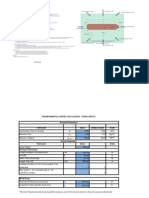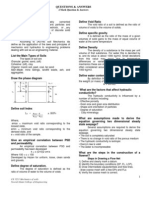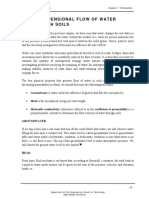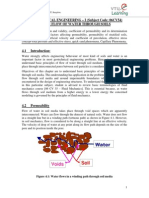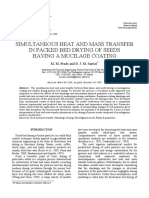Chapter 3
Chapter 3
Uploaded by
Fenta NebiyouOriginal Title
Copyright
Available Formats
Share this document
Did you find this document useful?
Is this content inappropriate?
Report this DocumentCopyright:
Available Formats
Chapter 3
Chapter 3
Uploaded by
Fenta NebiyouCopyright:
Available Formats
Addis Ababa University, Faculty of Technology, Department of Civil Engineering
Chapter Three
One-Dimensional Flow of Water through Soils
3. Introduction.........................................................................................................................2
3.1 Definitions of key Terms..................................................................................................2
3.2 Groundwater........................................................................................................................2
3.3 Head........................................................................................................................................2
3.4 Darcy’s Law..........................................................................................................................4
3.5 Empirical Relationships for k.........................................................................................5
3.6 Flow Parallel to Soil Layers.............................................................................................7
3.7 Flow Normal to Soil Layers.............................................................................................8
3.8 Determination of the Coefficient of Permeability...................................................9
3.8.1 Constant-Head Test.......................................................................................................9
3.8.2 Falling-Head Test..........................................................................................................10
3.8.3 Pumping Test to Determine the Coefficient of Permeability........................12
Soil Mechanics I: Lecture Notes Instructor: Dr. Hadush Seged
Addis Ababa University, Faculty of Technology, Department of Civil Engineering
3. Introduction
In chapter 2, we have discussed particle sizes and index properties and
used these to classify soils. You know that water changes the soil states in fine-
grained soils; the greater the water content in the soil the weaker it is (IL
increases). Soils are porous materials much like sponges. Water can flow between
the interconnected voids. Particle sizes and structural arrangement of the particles
influence the rate of flow. In table 2.7, you should have noticed that one of the
important soil properties is permeability. In this chapter, we will discuss soil
permeability by considering one-dimensional flow of water through soils. When you
complete this chapter you should be able to:
Determine the rate of flow of water through soils.
3.1 Definitions of key Terms
Groundwater is water under gravity in excess of that required to fill the soil pores.
Head (H) is the mechanical energy per unit weight.
Coefficient of permeability (k) is a proportionality constant to determine the
flow velocity of water through soils.
3.2 Groundwater
We will be discussing gravitational flow of water under a steady state
condition. You may ask: “What is a steady state condition?” Gravitational flow can
only occur if there is a gradient. Flow takes place downhill. The steady state flow
occurs if neither the flow nor the pore water pressures change with time. Pore
water pressure is the water pressure within the voids.
If you dig a hole into a soil mass that has all the voids filled with water (fully
saturated), you will observe water in the hole up to a certain level. This water level
is called groundwater level or groundwater table and exists under a hydrostatic
condition. A hydrostatic condition occurs when the flow is zero. The top of the
groundwater level is under atmospheric pressure. We will denote the groundwater
table by the symbol ▼.
3.3 Head
Darcy’s law governs the flow of water through soils. But before we delve into
Darcy’s law, we will discuss an important principle in fluid mechanics – Bernoulli’s
Soil Mechanics I: Lecture Notes Instructor: Dr. Hadush Seged 38
Addis Ababa University, Faculty of Technology, Department of Civil Engineering
principle – which is essential in understanding flow through soils.
If you cap one end of a tube, fill the tube with water, and then rest it on your
table (Fig. 3.1), the height of water with reference to your table is called the
pressure head (hP).
Figure 3.1: Illustration of elevation and pressure heads.
Head refers to the mechanical energy per unit weight. If you raise the tube above
the table, the mechanical energy or total head increases. You now have two
components of total head – the pressure head (hp) and the elevation head (hz). If
water were to flow through the tube with a velocity , under steady state condition,
then we have an additional head due to the velocity given as . The total head
(sometimes called piezometric head), H, according to Bernoulli’s principle is:
(3.1)
The elevation or potential head is referenced to an arbitrary datum and the
total head will change depending on the choice of the datum position. Therefore, it
is essential that you identify your datum position in solutions to flow problems.
Pressures are defined relative to atmospheric pressure. The velocity of flow through
soils is generally small (< 1 cm/s) and we usually neglect the velocity head. The
total head in soils is then
(3.2)
where u = whp is the pore water pressure.
Consider a cylinder containing a soil mass with water flowing through it at a
constant rate as depicted in Fig. 3.2. If we connect two tubes, A and B, called
piezometers, at a distance l apart, the water will rise to different heights in each of
Soil Mechanics I: Lecture Notes Instructor: Dr. Hadush Seged 39
Addis Ababa University, Faculty of Technology, Department of Civil Engineering
the tubes. The height of water in tube B near the exit is lower than A. Why? As the
water flows through the soil, energy is dissipated through friction with the soil
particles, resulting in a loss of head. The head loss between A and B, assuming
decrease in head is positive and our datum is arbitrarily selected at the top of the
cylinder, is ΔH = .
Figure 3.2: Head loss due to flow of water through soil.
3.4 Darcy’s Law
Darcy (1856) proposed that average flow velocity through soils is
proportional to the gradient of the total head. The flow in any direction, j, is
(3.3)
where v is the average flow velocity, k is a coefficient of proportionality called the
coefficient of permeability or hydraulic conductivity, and dH is the change in total
head over a distance dx. The unit of measurement for k is length/time, that is,
cm/s. With reference to Fig. 3.2, Darcy’s law becomes
(3.4)
where is the hydraulic gradient. Darcy’s law is valid for all soils if the flow
is laminar (Reynolds number < 1).
The average velocity, v, calculated from Eq. (3.4) is for the cross-sectional
area normal to the direction of flow. Flow through soils, however, happens only
through the interconnected voids. The velocity through the void spaces is called the
seepage velocity (vs) and is obtained by dividing the average velocity by the
porosity of the soil:
Soil Mechanics I: Lecture Notes Instructor: Dr. Hadush Seged 40
Addis Ababa University, Faculty of Technology, Department of Civil Engineering
(3.5)
The volume rate of flow, qv, or, simply, flow rate is the product of the average
velocity and the cross-sectional area:
(3.6)
The unit of measurement for q v is m3/s or cm3/s. The conservation of flow (law of
continuity) stipulates that the volume rate of inflow (qv)in into a soil element must
equal the volume rate of outflow, (qv)out, or, simply, inflow must equal outflow: (qv)in
= (qv)out.
The coefficient of permeability depends on the soil type, the particle size
distribution, the structural arrangement of the grains or void ratio, and the
wholeness (homogeneity, layering, fissuring, etc) of the soil mass. Typical value
ranges of kz for various soil types are shown in Table 2.7.
Table 3.1: Coefficient of permeability for common soil types
Soil type kz (cm/s)
Clean gravel > 1.0
Clean sands, clean sand and gravel mixtures 1.0 to 10-3
Fine sands, silts, mixtures comprising sands, silts, and clays 10-3 to 10-7
Homogeneous clays < 10-7
Homogeneous clays are practically impervious. Two popular uses of
“impervious” clays are in dam construction to curtail the flow of water through the
dam and as barriers in landfills to prevent migration of effluent to the surrounding
area. Clean sands and gravels are pervious and can be used as drainage materials
or soil filters.
3.5 Empirical Relationships for k
For a homogeneous soil, the coefficient of permeability depends
predominantly on its void ratio. You should recall that the void ratio is dependent on
the soil fabric and structural arrangement of the soil grains. A number of empirical
relationships have been proposed linking k to void ratio and grain size for coarse-
grained soils. Hazen (1930) proposed one of the early relationships as:
(2.31)
Soil Mechanics I: Lecture Notes Instructor: Dr. Hadush Seged 41
Addis Ababa University, Faculty of Technology, Department of Civil Engineering
where C is a constant varying between 0.4 and 1.2 if the unit of measurement of
D10 (effective diameter) is mm. Typically, C = 1.0. Other relationships were
proposed for coarse and fine-grained soils by Samarasinghe et al. (1982), Kenny et
al. (1984), and others. One has to be extremely cautious in using empirical
relationships for k because it is very sensitive to changes in void ratio and the
wholeness of your soil mass.
EXAMPLE 3.1
A soil sample 10 cm in diameter is placed in a tube 1 m long. A constant supply of
water is allowed to flow into one end of the soil at A and the outflow at B is
collected by a beaker (Fig. E3.1). The average amount of water collected is 1 cm 3
for every 10 seconds. The tube is inclined as shown in Fig. 3.1. Determine the (a)
hydraulic gradient, (b) flow rate, (c) average velocity, (d) seepage velocity, if e =
0.6, and (e) coefficient of permeability.
Figure E3.1
Strategy: For flow problems, you must define a datum position. So your first task
is to define the datum position and then find the difference in total head between A
and B. Use the head difference to calculate the hydraulic gradient and use Eqs. (3.4
to 3.6) to solve the problem.
EXAMPLE 3.2
A drainage pipe (Fig. E3.2) became completely blocked during a storm by a plug of
sand, 1.5 m long, followed by another plug of a mixture of clays, silts, and sands,
0.5 m long. When the storm was over, the water level above ground was 1 m. The
coefficient of permeability of the sand is 2 times that of the mixture of clays, silts,
and sands.
Soil Mechanics I: Lecture Notes Instructor: Dr. Hadush Seged 42
Addis Ababa University, Faculty of Technology, Department of Civil Engineering
(a) Plot the variation of pressure, elevation, and total head over the length of the
pipe.
(b) Calculate the pore water pressure at (1) the center of the sand plug and (2)
the center of the mixture of clays, silts, and sands.
(c) Find the average hydraulic gradients in the sand and in the mixture of clays,
silts and sands.
Figure E3.2a: Illustration of blocked drainage pipe.
Strategy: You need to select a datum. From the information given, you can
calculate the total head at A and B. The difference in head is the head loss over
both plugs but you do not know how much head is lost in the sand and in the
mixture of clays, silts, and sands. The continuity equation provides the key to
finding the head loss over each plug.
3.6 Flow Parallel to Soil Layers
When the flow is parallel to the soil layer (Fig. 3.2), the hydraulic gradient is
the same at all points. The flow through the soil mass as a whole is equal to the
sum of the flow through each of the layers. There is a similarity here with the flow
of electricity through resistors in parallel. If we consider a unit width (in the y
direction) of flow and use Eq. (3.6), we obtain,
(3.6)
where H0 is the total thickness of the soil mass, kx(eq) is the equivalent permeability
in the horizontal (x) direction, z1 to zn are the thickness of the first to the nth layers,
Soil Mechanics I: Lecture Notes Instructor: Dr. Hadush Seged 43
Addis Ababa University, Faculty of Technology, Department of Civil Engineering
and kx1 to kxn are the horizontal permeabilities of first to the nth layer. Solving Eq.
(3.6) for kx(eq), we get,
(3.7)
Fig. 3.2: Flow through stratified layers.
3.7 Flow Normal to Soil Layers
For flow normal to the soil layers, the head loss in the soil mass is the sum of
the head losses in each layer:
(3.8)
where ΔH is the total head loss, and Δh1 to Δhn are the head losses in each of the n
layers. The velocity in each layer is the same. The analogy to electricity is flow of
current through resistors in series. From Darcy’s law, we obtain
(3.9)
where kz(eq) is the equivalent permeability in the vertical (z) direction and kz1 to kzn
are the vertical permeabilities of the first to the nth layer. Solving Eqs. (3.8 and 3.9)
leads to
(3.10)
Values of kz(eq) are generally less than kx(eq) – sometimes as much as 10 times less.
EXAMPLE 3.3
Soil Mechanics I: Lecture Notes Instructor: Dr. Hadush Seged 44
Addis Ababa University, Faculty of Technology, Department of Civil Engineering
A canal is cut into a soil with a stratigraphy shown in Fig. E3.3. Assuming flow takes
place laterally and vertically through the sides of the canal and vertically below the
canal, determine the equivalent permeability in the horizontal and vertical
directions. Calculate the ratio of the equivalent horizontal permeability to the
equivalent vertical permeability for flow through the sides of the canal.
Fig. E3.3
Strategy: Use Eqs. (3.7 and 3.10) to find the equivalent horizontal and vertical
permeabilities over the depth of the canal (3 m) and then use Eq. (3.10) to find the
equivalent vertical permeability below the canal. To make the calculations easier,
convert all exponential quantities to a single exponent.
Soil Mechanics I: Lecture Notes Instructor: Dr. Hadush Seged 45
Addis Ababa University, Faculty of Technology, Department of Civil Engineering
3.8 Determination of the Coefficient of Permeability
3.8.1 Constant-Head Test
Fig. 3.3: A constant-head apparatus.
The constant-head test is used to determine the coefficient of permeability of
coarse-grained soils. A typical constant-head apparatus is shown in Fig. 3.3. Water
is allowed to flow through a cylindrical sample of soil under a constant head (h).
The outflow (Q) is collected in a graduated cylinder at a convenient duration (t).
With reference to Fig. 3.2,
The flow rate through the soil is qv = Q/t, where Q is the total quantity of water
collected in the measuring cylinder over time t.
From Eq. (3.10),
(3.11)
where kz is the coefficient of permeability in the vertical direction.
The viscosity of the fluid, which is a function of temperature, influences the
value of k. The experimental value (kT0C) is corrected to a baseline temperature of
200C using
Soil Mechanics I: Lecture Notes Instructor: Dr. Hadush Seged 46
Addis Ababa University, Faculty of Technology, Department of Civil Engineering
(3.12)
0
where μ is the viscosity of water, T is the temperature in C at which the
measurement was made, and RT = μT℃/μ20℃ is the temperature correction factor
that can be calculated from,
(3.13)
3.8.2 Falling-Head Test
The falling-head test is used for fine-grained soils because the flow of water
through these soils is too slow to get reasonable measurements from the constant-
head test. A compacted soil sample or a sample extracted from the field is placed in
a metal or acrylic cylinder (Fig. 3.4).
Fig. 3.4: A constant-head apparatus.
Porous stones are positioned at the top and bottom faces of the sample to prevent
its disintegration and to allow water to percolate through it. Water flows through
the sample from a standpipe attached to the top of the cylinder. The head of water
(h) changes with time as flow occurs through the soil. At different times, the head
of water is recorded. Let dh be the drop in head over a time period dt. The velocity
or rate of head loss in the tube is
Soil Mechanics I: Lecture Notes Instructor: Dr. Hadush Seged 47
Addis Ababa University, Faculty of Technology, Department of Civil Engineering
and the inflow of water to the soil is
where a is the cross-sectional area of the tube. We now appeal to Darcy’s law to get
the outflow:
where A is the cross-sectional area, L is the length of the soil sample, and h is the
head of water at any time t. The continuity condition requires that (qv)in = (qv)out.
Therefore,
By separating the variables (h and t) and integrating between that appropriate
limits, the last equation becomes,
(3.14)
EXAMPLE 3.4
A sample of sand, 5 cm in diameter and 15 cm long, was prepared at a porosity of
60% in a constant-head apparatus. The total head was kept constant at 30 cm and
the amount of water collected in 5 seconds was 40 cm 3. The test temperature was
200C. Calculate the coefficient of permeability and the seepage velocity.
Strategy: From the data given, you can readily apply Darcy’s law to find k.
EXAMPLE 3.5
The data from a falling-head test on a silty clay are
Cross-sectional area of soil = 80 cm2 Duration of test = 15 minutes
Length of soil = 10 cm Diameter of tube = 6 mm
Initial head = 90 cm Temperature = 220C
Soil Mechanics I: Lecture Notes Instructor: Dr. Hadush Seged 48
Addis Ababa University, Faculty of Technology, Department of Civil Engineering
Final head = 84 cm
Determine k.
Strategy: Since this is a falling-head test, you should use Eq. 3.14. Make sure you
are using consistent units.
3.8.3 Pumping Test to Determine the Coefficient of Permeability
One common method of determining the coefficient of permeability in the field
is by pumping water at a constant flow rate from a well and measuring the
decrease in ground water level at observation wells (Fig. 3.5).
Fig. 3.5: Layout of a pump test to determine k.
The equation, called the simple well formula, is derived using the following
assumptions.
Soil Mechanics I: Lecture Notes Instructor: Dr. Hadush Seged 49
Addis Ababa University, Faculty of Technology, Department of Civil Engineering
1. The pumping well penetrates through the water-bearing stratum and is
perforated only at the section that is below the groundwater level.
2. The soil mass is homogeneous, isotropic, and of infinite size.
3. Darcy’s law is valid.
4. Flow is radial towards the well.
5. The hydraulic gradient at any point in the water-bearing stratum is constant and
is equal to the slope of groundwater surface (Dupuit’s assumptions).
Let dz be the drop in total head over a distance dr. Then according to Dupuit’s
assumption the hydraulic gradient is
The area of flow at a radial distance r from the center of the pumping well is
where z is the thickness of an elemental volume of the pervious soil layer. From
Darcy’s law, the flow is:
We need to rearrange the above equation and integrate it between the limits r1 and
r2, and h1 and h2:
Completing the integration leads to:
(3.15)
With measurements of r1, r2, h1, h2, and qv (flow rate of the pump), k can calculated
using Eq. (3.15). This test is only practical for coarse-grained soils.
Pumping tests lower the groundwater, which then causes stress changes in the
soil. Since the groundwater is not lowered uniformly as shown in Fig. 3.5, the stress
changes in the soil will not be even. Consequently, pumping tests near existing
structures can cause them to settle unevenly. You should consider the possibilities
of differential settlement on existing structures when you plan a pumping test. Also,
it is sometimes necessary to temporarily lower the groundwater level for
construction. The process of lowering the groundwater is called dewatering.
EXAMPLE 3.6
Soil Mechanics I: Lecture Notes Instructor: Dr. Hadush Seged 50
Addis Ababa University, Faculty of Technology, Department of Civil Engineering
A pumping test has been carried out in a soil bed of thickness 15 m and the
following measurements were recorded. Rate of pumping was 10.6×10 -3 m3/s;
drawdowns in observation wells located at 15 m and 30 m from the center of the
pumping well were 1.6 m and 1.4 m, respectively, from the initial groundwater
level. The initial groundwater level was located at 1.9 m below the initial ground
level. Determine k.
Strategy: You are given all measurements to directly apply Eq. (3.15) to find k.
You should draw a sketch of the pump test to identify the values to be used in Eq.
(3.15).
Soil Mechanics I: Lecture Notes Instructor: Dr. Hadush Seged 51
You might also like
- Permeability of SoilDocument58 pagesPermeability of SoilAntony GodwinNo ratings yet
- OCIMF Environment Forces Calculator On VLCCDocument9 pagesOCIMF Environment Forces Calculator On VLCCshahjada100% (1)
- Chapter3-One - Dimensional Flow of Water Through SoilsDocument12 pagesChapter3-One - Dimensional Flow of Water Through SoilsBirhanuNo ratings yet
- Chapter-3 Soil Permeability and SeepageDocument24 pagesChapter-3 Soil Permeability and SeepageLemiNo ratings yet
- chapter 3 permeability & seepage analyisisDocument30 pageschapter 3 permeability & seepage analyisiskemalNo ratings yet
- Chapter 3 PDFDocument23 pagesChapter 3 PDFmidju dugassaNo ratings yet
- Soil Mechanics Chapter 8.0Document17 pagesSoil Mechanics Chapter 8.0Marthur TamingNo ratings yet
- Chapter - Four Soil Permeability and SeepageDocument19 pagesChapter - Four Soil Permeability and SeepageBefkadu KurtaileNo ratings yet
- Ground Water Movement: 3.1 Darcy'S LawDocument19 pagesGround Water Movement: 3.1 Darcy'S LawAzman AzmanNo ratings yet
- Flow of Water Through SoilsDocument11 pagesFlow of Water Through SoilsRajesh KhadkaNo ratings yet
- Permeability LessonsDocument13 pagesPermeability LessonsHiel FuentesNo ratings yet
- Chapter 3 CONTAMINANT TRANSPORTDocument9 pagesChapter 3 CONTAMINANT TRANSPORTtinoNo ratings yet
- CH - 3Document46 pagesCH - 3Mo KopsNo ratings yet
- Cours HydrogeologieDocument57 pagesCours HydrogeologieMax Andri'aNo ratings yet
- LWCE-402 L#06 (A)Document16 pagesLWCE-402 L#06 (A)Muhammad HaseebNo ratings yet
- Available at VTU HUB (Android App) : Atme College of Engineering, MysuruDocument32 pagesAvailable at VTU HUB (Android App) : Atme College of Engineering, MysuruRahul Singh PariharNo ratings yet
- Hydraulic ConductivityDocument8 pagesHydraulic ConductivityJill AndersonNo ratings yet
- Chapter 3 PermeabilityDocument27 pagesChapter 3 PermeabilityLivingstone LGNo ratings yet
- DrahmedsoilMechanicsnoteschapter5 PDFDocument61 pagesDrahmedsoilMechanicsnoteschapter5 PDFRavaliNo ratings yet
- Steady-State Water Flow in Porous Media: Hillel, 1982Document5 pagesSteady-State Water Flow in Porous Media: Hillel, 1982mikiprofaNo ratings yet
- Ce 322-15 Module 7 - Permeability of SoilsDocument10 pagesCe 322-15 Module 7 - Permeability of SoilsBryanHarold BrooNo ratings yet
- Dr. Ahmed Soil Mechanics Notes Chapter Five (Permeability and Seepage Through Soil)Document62 pagesDr. Ahmed Soil Mechanics Notes Chapter Five (Permeability and Seepage Through Soil)AhmadAliAKbarPhambraNo ratings yet
- Reservoir Lab (PermeabilityDocument12 pagesReservoir Lab (PermeabilityAhmed AmirNo ratings yet
- Module 2 - Lesson 1 AbstractionDocument13 pagesModule 2 - Lesson 1 AbstractionRachel Palma GilNo ratings yet
- CH 3Document3 pagesCH 3Mohamed Abd El-MoniemNo ratings yet
- Ydrology Ecture Ifteen: G: D ' L F N D - K A. RDocument37 pagesYdrology Ecture Ifteen: G: D ' L F N D - K A. Rakshay sewcharanNo ratings yet
- PermebilityDocument14 pagesPermebilityEvi.safitriNo ratings yet
- Darcy's Law For Filow of Water in Soils PDFDocument20 pagesDarcy's Law For Filow of Water in Soils PDFmohamedtsalehNo ratings yet
- Mal1033: Groundwater Hydrology: Principles of Groundwater FlowDocument53 pagesMal1033: Groundwater Hydrology: Principles of Groundwater Flowomed muhammadNo ratings yet
- Topic 3Document54 pagesTopic 3HCNo ratings yet
- Earthened DamsDocument16 pagesEarthened Damsgopisrt100% (1)
- Lesson 8Document16 pagesLesson 8Joash SalamancaNo ratings yet
- CE 1251 - Mechanics of SoilsDocument7 pagesCE 1251 - Mechanics of SoilsManeesh SaxenaNo ratings yet
- Assgnment Soil MechDocument7 pagesAssgnment Soil MechJoe NjoreNo ratings yet
- Hydraulic ConductivityDocument7 pagesHydraulic ConductivityDragomir Gabriela MarianaNo ratings yet
- ReviewerDocument7 pagesReviewerRamces SolimanNo ratings yet
- One-Dimensional Flow of Water Through Soils: GroundwaterDocument11 pagesOne-Dimensional Flow of Water Through Soils: GroundwaterbiniNo ratings yet
- Basic HydrogeologyDocument7 pagesBasic HydrogeologyNeeraj D SharmaNo ratings yet
- Permeability Test Lab ReportDocument5 pagesPermeability Test Lab ReportSaleem Anas100% (3)
- DischargeDocument9 pagesDischargeshivabarwalNo ratings yet
- Presentation On Geology and Soil Mechanics: Submitted By-Titiksha Negi B.Tech (Ce) 4 SEMDocument21 pagesPresentation On Geology and Soil Mechanics: Submitted By-Titiksha Negi B.Tech (Ce) 4 SEMTitiksha NegiNo ratings yet
- Third: Chapter FiveDocument44 pagesThird: Chapter Fivefeten chihiNo ratings yet
- Dr. Farhan Altaee 2 Semester/lecture TwoDocument12 pagesDr. Farhan Altaee 2 Semester/lecture TwoMohammad AbbasNo ratings yet
- PermeabilityDocument11 pagesPermeabilityCalebNo ratings yet
- Geotecheng Module 02 Chapter 04Document23 pagesGeotecheng Module 02 Chapter 04Analisa DungcaNo ratings yet
- Darcy's LawDocument5 pagesDarcy's LawEKWUE ChukwudaluNo ratings yet
- Ce 382 Chapter 7 Permeability 1442 RevisedDocument72 pagesCe 382 Chapter 7 Permeability 1442 RevisedSobhuza ThembalethuNo ratings yet
- Chapter 3 Surface RunoffDocument10 pagesChapter 3 Surface RunoffAdron LimNo ratings yet
- SoilDocument5 pagesSoilNoel AbeledaNo ratings yet
- Soil ConsolidationDocument6 pagesSoil ConsolidationasaadfaramarziNo ratings yet
- Lab 3 - SeepageTankDocument6 pagesLab 3 - SeepageTankPrantik MaityNo ratings yet
- Hydraulics & Hydrology (CVE 705) - Module 6Document52 pagesHydraulics & Hydrology (CVE 705) - Module 6mohammed adoNo ratings yet
- PermeabilityDocument26 pagesPermeabilityvijjikewlguy7116100% (3)
- Soil ConsolidationDocument15 pagesSoil Consolidationchandakasuresh139No ratings yet
- Groundwater CWDocument16 pagesGroundwater CWemaxoneeNo ratings yet
- Seepage and Flow NetsDocument28 pagesSeepage and Flow Netsihsan ul haq100% (1)
- CE240 Lect W043 Permeability 1Document41 pagesCE240 Lect W043 Permeability 1ridminjNo ratings yet
- Permeability TheoryDocument33 pagesPermeability TheoryDhananjay ShahNo ratings yet
- Groundwater Lecture NotesDocument16 pagesGroundwater Lecture NotesGourav PandaNo ratings yet
- RC II - chapter-4-LNDocument67 pagesRC II - chapter-4-LNFenta NebiyouNo ratings yet
- RC II - chapter-2-LNDocument32 pagesRC II - chapter-2-LNFenta NebiyouNo ratings yet
- RC II Chapter 1 Ex 1Document13 pagesRC II Chapter 1 Ex 1Fenta NebiyouNo ratings yet
- Chapter 5Document22 pagesChapter 5Fenta NebiyouNo ratings yet
- Chapter 1Document11 pagesChapter 1Fenta NebiyouNo ratings yet
- Chapter 2Document27 pagesChapter 2Fenta NebiyouNo ratings yet
- Alebachew HDP2019 LAST Submited To HDPDocument20 pagesAlebachew HDP2019 LAST Submited To HDPFenta NebiyouNo ratings yet
- Chapter 6Document7 pagesChapter 6Fenta NebiyouNo ratings yet
- Alebachew HDP Ra1 Last2019Document11 pagesAlebachew HDP Ra1 Last2019Fenta NebiyouNo ratings yet
- Ale HDP Organizational Placement2019Document18 pagesAle HDP Organizational Placement2019Fenta NebiyouNo ratings yet
- Adola Proposal On SWDocument11 pagesAdola Proposal On SWFenta NebiyouNo ratings yet
- TC533 SelectAutomationDocument1 pageTC533 SelectAutomationstephenhNo ratings yet
- Experiment No:-1: AIM: - Apparatus: - TheoryDocument5 pagesExperiment No:-1: AIM: - Apparatus: - Theorydeepesh chhetriNo ratings yet
- Webb, Eckert, Goldstein - 1972 - Generalized Heat Transfer and Friction Correlations For Tubes With Repeated Rib RoughnessDocument5 pagesWebb, Eckert, Goldstein - 1972 - Generalized Heat Transfer and Friction Correlations For Tubes With Repeated Rib RoughnessKau Carlos XavierNo ratings yet
- Structures Lab ManualDocument40 pagesStructures Lab ManualAakif AmeenNo ratings yet
- Earth Fault Protection - TutorialDocument7 pagesEarth Fault Protection - Tutorialedna sisayNo ratings yet
- Emailing دوسية المهندس ابراهيم النوافلة-1Document61 pagesEmailing دوسية المهندس ابراهيم النوافلة-1ahmadalialhamaida19971015No ratings yet
- DownloadDocument12 pagesDownloadThor Is PlayingNo ratings yet
- Chapter #4 Chapter #4 Chapter #4: Liquids and Solids Liquids and Solids Liquids and SolidsDocument34 pagesChapter #4 Chapter #4 Chapter #4: Liquids and Solids Liquids and Solids Liquids and SolidsStatus LandNo ratings yet
- DeLonghi NF170 ManualDocument11 pagesDeLonghi NF170 ManualgggahshNo ratings yet
- Physics Mdcat: D) 4 L A) Sine WaveDocument6 pagesPhysics Mdcat: D) 4 L A) Sine WaveahmedNo ratings yet
- Fin Worksheet VIllanueva RubyDocument4 pagesFin Worksheet VIllanueva RubyAllen James VillanuevaNo ratings yet
- SSIService PartsDocument19 pagesSSIService PartssamNo ratings yet
- 1H1 Plastic Drum Non Removable HeadDocument1 page1H1 Plastic Drum Non Removable HeadMASTER SOURCENo ratings yet
- Delta Industrial Articulated Robot SeriesDocument15 pagesDelta Industrial Articulated Robot Seriesrobotech automationNo ratings yet
- 4th Semester SyllabusDocument14 pages4th Semester Syllabus507 20L SK DarainNo ratings yet
- CT MCQ BankDocument35 pagesCT MCQ BankSakshi TalmaleNo ratings yet
- STP 1546-2012Document390 pagesSTP 1546-2012HieuHTNo ratings yet
- Subsystems: Radar Antennas Radar Transmitters Radar Receivers Radar Exciters The Radar Signal ProcessorDocument39 pagesSubsystems: Radar Antennas Radar Transmitters Radar Receivers Radar Exciters The Radar Signal ProcessorandavarezNo ratings yet
- Jac Class 11TH Term 2 Marking SchemeDocument22 pagesJac Class 11TH Term 2 Marking Schemescience vision chemistryNo ratings yet
- Applied Partial Differential Equations - J. David Logan-1998Document2 pagesApplied Partial Differential Equations - J. David Logan-1998Jeremy Mac LeanNo ratings yet
- Assignment (Solid State) Final (E)Document17 pagesAssignment (Solid State) Final (E)Gulshan RahejaNo ratings yet
- Real Final ResumeDocument1 pageReal Final ResumeDANIEL PHELKANo ratings yet
- Wittenburg Dynamics of Systems of Rigid BodiesDocument223 pagesWittenburg Dynamics of Systems of Rigid Bodiesxogus6216No ratings yet
- Mass & Balance Q&ADocument109 pagesMass & Balance Q&AAdwikaNo ratings yet
- Technical Sheet Vaso Inerziale BuferDocument2 pagesTechnical Sheet Vaso Inerziale BuferJovisa MaricNo ratings yet
- Rheological Properties of PolymersDocument23 pagesRheological Properties of PolymersAbdullah AlkalaliNo ratings yet
- 210-06 Kinetics of ParticlesDocument6 pages210-06 Kinetics of ParticlesBrck Heart's Aqil MubarakNo ratings yet
- Types of DC MotorsDocument5 pagesTypes of DC MotorsRolen GeocadinNo ratings yet
- Origin of Gravity and Mass - A New ThinkingDocument19 pagesOrigin of Gravity and Mass - A New ThinkingJohn PailyNo ratings yet

